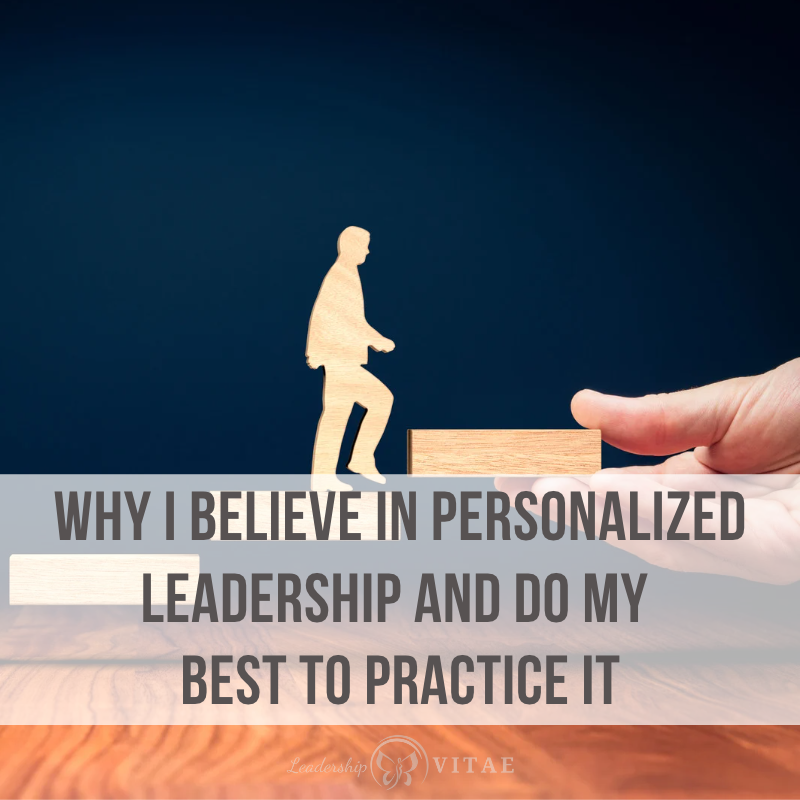
Over the years, I’ve heard of many kinds of leadership approaches. Servant leadership. Situational leadership. The list goes on.
One that I haven’t heard is personalized leadership, yet that’s how I like to think of my approach. Like servant leadership, it focuses on the people we are attempting to lead. This goes a level deeper, however, to really understand the individual and integrate their interests and preferences into how we engage.
Depending on the size of our team and scope of responsibilities, it may seem daunting to really know our team members. Yet I’ve worked for leaders who had massive teams and still remembered key things about me that they integrated into our interactions.
It makes a world of difference to our people when they feel like they matter. Our teams will go the extra mile, work harder, and raise issues earlier when they feel seen and heard.
We don’t have to know everything about our people to personalize interactions and our leadership approach. We don’t even need to do this with all of our people to have an impact on large teams. A little can go a long way if we have a genuine interest and reflect that back to our people.
What does personalized leadership look like in practice?
The power of a movie trailer
It’s been many years now, but I still remember the email. The subject was “Important topic for our 1×1.” There was trepidation as I opened the note.
Inside, I’d find a link to the latest Star Wars movie trailer along with the message “Be prepared to discuss.”
My manager knew I was (am) a huge Star Wars fan. He’s a movie aficionado and loved having conversations with me about whatever movies I enjoyed. While he watches all of the Best Picture nominees each year, I’m not so inclined. Where we overlapped, such as Star Wars, he would happily dissect trailers and possible plot lines.
It may seem like a small thing to most people, but that experience was one of many where I felt seen. He took something he knew I was interested in and integrated it into our interactions, such as that 1×1.
Small moments lead to big trust
Those meaningful interactions went beyond movies. He would give me guidance and try to make sure it was aligned to how I show up. If I had concerns about how to do something in a way that felt natural, he’d talk me through it. That personalized feedback, aligned to me as a whole person, made it easier for me to implement change that otherwise might have been a struggle.
There were so many examples personally and professionally. It helped establish a trusting bi-directional relationship where I’d feel comfortable bringing my whole self to work. Later, when life was wonky navigating a divorce, I was more open with him than I would have been with any other person I had worked for. He made a point to ask me how my son was faring through it, which made a huge difference as a working parent.
That’s where personalized leadership really shines. By taking small opportunities to listen and integrate what we hear in our interactions, we build trust. That trust allows us to be there and support our team members when they are having a big moment. We can only be there if we know about it, and we’re more likely to know when we have established we care and want to know.
Make it personal
If we want to have personal, transparent, and vulnerable conversations with our people, we need to lead the way. When we offer information about our families or Sunday scaries, we invite that type of insight in return.
This example has been shared before, but it’s worth repeating. I was new in my current company and meeting all of my team members. It was the first conversation with a woman in India and I asked how she was doing. “Fine,” she said.
When she asked how I was doing, I told her. New job, kid returning to in-person school and a new Freshman. It was a bit of a chaotic time. “Oh, we’re sharing the truth” was her response.
From there, she told me about planning to leave her home for the first time in 18 months later that week. We had a very different conversation than we would have if my answer had been “fine” as well. If we lead with fine, that’s what we’ll get. When we open the door to the truth, we’re more likely to get it in return.
By modeling transparency and vulnerability, we invite the same. We encourage and make it safe for our people to let us know what is going on with them.
A window into our humanity
The window into our humanity goes beyond our home lives. As leaders, we are often seen as having our act together and knowing the answers. We know the reality is quite different, but are we building transparency into that reality, or cultivating a persona?
If we want to see our people, we have to commit to being seen. Especially if we want to create new leaders. Our work struggles need to be part of the conversation if we want to make leadership accessible and create a safe environment to discuss such challenges.
Maybe we struggle with back-to-back meetings and are going to the new option for 50-minute ones. Share the struggle and the test. Ask for input on how it’s going. Then, when that team member is struggling with something else like a challenging customer, they are more likely to open up. To share what they’ve tried and ask for input on other options.
The same leader that discussed movies also discussed his decision-making and what was influencing it. He was open about the good and the bad of executive leadership, providing me with invaluable insight for when it was my turn at the wheel. He spoke of the pressures to fit in, and the risks of standing out that he (rightly) believed I would face along the way.
To me, this is what it looks like to practice personalized leadership. It means showing who we are, our struggles, and the why behind our wins. It is also centering the other person and giving them insights that matter to THEM, their dreams, challenges, and opportunities.
Have you practiced or experienced personalized leadership? What else would you add? Please share your thoughts in the comments to bring this concept to life.








